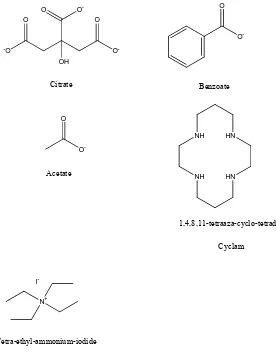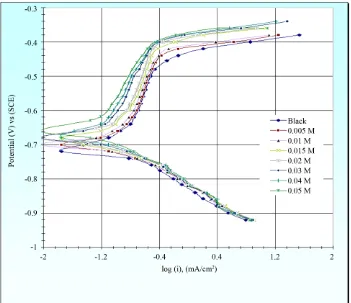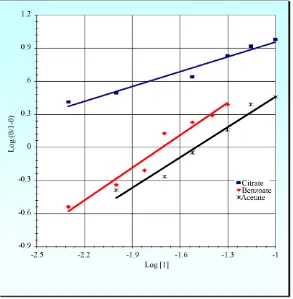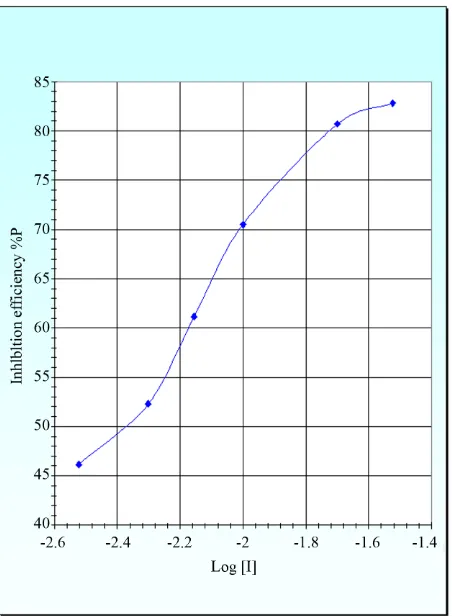http://dx.doi.org/10.4236/ojpc.2013.34022
Electrochemical Corrosion Behavior of Aluminum in
Perchloric Acid
F. M. Mahgoub1,2
1Department of Chemistry, Faculty of Science, King Abdulaziz University, Jeddah, KSA 2Department of Materials Science, Institute of graduate Studies and Research,
Alexandria University, Alexandria, Egypt Email: ftm_mahgoub@yahoo.com
Received September 26, 2013; revised October 23, 2013; accepted October 30, 2013
Copyright © 2013 F. M. Mahgoub. This is an open access article distributed under the Creative Commons Attribution License, which permits unrestricted use, distribution, and reproduction in any medium, provided the original work is properly cited.
ABSTRACT
The effects of acetate, citrate, benzoate, tetra-ethylammonium iodide (TEA) and 1,4,8,11 tetra-azacyclo-tetradecane (cyclam) on the corrosion behavior of aluminum in 1 M HClO4 at 40˚C were studied by potentiodynamic polarization technique. Acetate, citrate, and benzoate inhibited the corrosion of aluminum and shifted the breakdown potential to positive direction. Cyclam was investigated as a macrocyclic organic inhibitor to the acid corrosion of aluminum. The addition of cyclam to the corroding medium showed a pronounced effect on the anodic but not on the cathodic part of the polarization curve. The addition of TEA to the medium enhanced the corrosion rate and shifted the breakdown po- tential to more negative value as the concentration increased. The results were discussed on the basis of the adsorption mechanism and the nature of the adsorbed species.
Keywords: Metals; Electrochemical Techniques; Corrosion
1. Introduction
Corrosion and passivation of aluminum are a subject of tremendous technological importance due to the in- creased industrial applications of these materials [1,2]. The widespread use of aluminum arises from its different physical and chemical properties, namely, it has low spe- cific gravity, good thermal and electrical conductivity and relatively low toxicity [3]. It also exhibits significant resistance to corrosion because of the rapid formation of a passive oxide film [4]. However, because of the general aggression of acid solutions, inhibitor is commonly used to reduce corrosive attack on metallic surface [5]. There are two types of inhibitors; passivators and pickling in- hibitors. Passivators have the property of shifting the corrosion potential to more anodic values. Pickling in-hibitors, in spite of leaving the corrosion potential vir- tually unaffected, cause a significant decrease in the cor- rosion rate [6]. A large number of investigations have been reported on adsorption of anions on aluminum cor- rosion and their inhibition or stimulation effects on ag- gressive acid media [7-13]. Recent study has been con- cerned with the effects of various inorganic additives, such as nitrate, nitrite, thiocyanate and chromate on the
corrosion of aluminum in 1 M HClO4 at 40˚C [14]. In the present work, potentiodynamic polarization technique was used to study the effect of different organic additives vis., acetate, citrate, benzoate, tetraethyl ammonium io- dide and cyclam on the electrochemical corrosion be- havior of aluminum in 1 M HClO4 at 40˚C and their ad- sorption mechanism.
2. Experimental
Experiments were performed with highly pure aluminum (99.99%) specimens, in the form of rods, were cut to give an area 1.13 cm2 and subsequently mechanically polished using emery paper up to 1200 grade. The specimens were then washed, degreased with acetone, dried and finally left to equilibrate for 5 min. at room temperature prior to testing. This procedure gave good reproducibility of re- sults.
further purification.
An ASTM [15,16] electrochemical cell containing a platinum coil counter electrode and a saturated calomel reference electrode inserted into a luggin capillary was used to conduct the tests. The working electrode was the specimens to be tested. Electrochemical corrosion tests were carried out in deaerated, unstirred solutions using purified nitrogen gas.
Before polarisation, the working electrode was intro- duced into the solution and left for 10 min at the open circuit potential. Polarization was then carried out at a rate of 0.03 Vmin−1 using a Wenking potentiostat. Ca- thodic polarization was first carried out to ensure reduce- tion of air formed native oxides and cleaning of the sur- face before shifting the potential towards more positive values. No corrections for IR drops were carried out since the Luggin probe tip was properly aligned to the electrode surface (1 - 3 mm). A constant temperature of 40˚C (±0.5˚C) was maintained using a thermostatically controlled water bath. The investigated compounds are shown in Figure 1.
3. Results and Discussion
3.1. Effect of Benzoate, Citrate and Acetate
Typical potentiodynamic polarization curves for alumi- num in 1 M HClO4 at 40˚C in the presence and the ab- sence of different concentration of benzoate ion is shown in Figure 2. As seen, addition of benzoate ions pre-
dominantly affects the anodic part of the polarization curves rather than the cathodic part of the curves. Inspec- tion of the anodic part of the polarization curves reveals that it consists of three different regions. On passing from open circuit towards more anodic potentials an ac- tive region for dissolution of aluminum takes place, sub- sequent by a passive region where a nearly constant cur- rent density is observed, finally the transpassive region, where a sharp increase in the current density is noticed. The passive region demonstrates the growth of the pas- sive oxide film.
Acetate and citrate ions gave similar behavior on the corrosion of aluminum in HClO4 at 40˚C. The effect of increasing citrate, benzoate, and acetate concentration on
Citrate
OH O
O
-O O
-O
-O
Benzoate
O
O
-Acetate
O
O
-1,4,8,11-tetraaza-cyclo-tetradecane
HN
HN NH NH
Cyclam
Tetra-ethyl-ammonium-iodide
N+
I
[image:2.595.152.428.347.702.2]-(TEA)
Figure 2. Potentiodynamic polarization curves of aluminum metal in 1.0 M HClO4 containing different concentrations of so- dium benzoate.
the breakdown potential Ep and corrosion potential Ecorr
as well as corrosion current density i, are given in Table 1. The selected data indicate that addition of citrate ions
to perchloric acid solutions shifts Ecorr to significantly
more anodic values. On the other hand, addition of Ben- zoate and acetate ions has a small influence on Ecorr. The breakdown potential, at any given concentration, is found to be in the order acetate > benzoate > citrate. The corro- sion current density obtained by Tafel extrapolation of the active region decreases for all tested anions with in- creasing the concentration inhibitor.
Figure 3 shows the protection efficiency %P vs. the
logarithmic concentration of citrate, benzoate, and ace- tate. %P were estimated using the equation
%P 1 i io 100
where, ioand i is the corrosion current density in the ab-
[image:3.595.308.538.465.652.2]sence and the presence of additives, respectively. All the plots have S-shaped adsorption isotherm. This suggests that these anions inhibit the acid dissolution by adsorption at the aluminum—acid solution interface. Inspection of this figure shows that citrate has the highest inhibition efficiency, while acetate has the lowest one. Similar observation is obtained by Scully and Rude [17] for the corrosion of aluminum in 0.08 M NaCl at pH 8.
Table 1. Electrochemical parameters of aluminum in per- chloric acid in absence and presence of different concentra- tions of Citrate, Benzoate and Acetate.
Adittives [C], mol/L Ecorr, V i, A/cm2 Ep, V
- 0.00 −0.712 66 −0.460
0.010 −0.578 16.1 −0.418
0.030 −0.562 12.1 −0.405
Citrate
0.050 −0.540 8.5 −0.393
0.01 −0.685 45.3 −0.438
0.03 −0.665 24.5 −0.415
Benzoate
0.050 −0.650 19.1 −0.396
0.01 −0.684 46.7 −0.450
0.030 −0.669 34.7 −0.425
Acetate
0.050 −0.666 26.7 −0.420
Figure 4 shows the variation of pitting potential Epit
Figure 3. Relationship between inhibition efficiency and logarithm of concentrations of citrate, benzoate and acetate.
Figure 4. Relationship between Ep and logarithm of concentrations of citrate, benzoate and acetate.
[image:4.595.157.441.372.718.2]retarding pitting corrosion of aluminum in 1 M HClO4 is ordered in the sequence citrate > benzoate > acetate.
These results are interpreted as due to structure effect, where the higher efficiency of the first inhibitor citrate is interpreted as due to the presence of three carboxylic groups (−Coo−) which increase the adsorption on the
surface of the aluminum metal in 1 M HClO4. On the other hand, Benzoate more efficient than acetate is inter- preted as due to the presence of phenyl group attached to the carboxylic group (−Coo−), leading to increase of the
electron density and then increase the adsorption on the aluminum metal [18].
Compounds containing the carboxylic groups may be considered to have affected the surface of the specimens in two ways: a) by adsorption and subsequent formation of stable surface complexes and b) by blocking of the active sites for the dissolution of the oxide layers [19].
Adsorption Isotherms
To clarify the nature of adsorption, theoretical fitting of different isotherms, Langmuir, Frumkin, Flory-Huggins and the kinetic-thermodynamic model are tested.
The degree of surface coverage of the metal surface by an adsorbed anion is calculated using the equation
1 i io
The adsorption of an organic inhibitor adsorbed on the surface of a metal is regarded as a substitution adsorption process between the organic compound in the aqueous phase, Org.(aq), and the water molecule adsorbed on the electrode surface H2O(s) [20]
aq 2 s s 2 aq
Org. xH O Org. xH O
where, x is the size ratio which is the number of water molecules replaced by one molecule of an organic ad- sorbate.
The Langmuir isotherm is given by [21]:
1
K C
where K is the binding constant representing the interact- tion of the additives with metal surface and C is the con- centration of the additives.
Frumkin isotherm is given by [22]:
1
exp 2a K C
where, a, is a molecular interaction parameter depending on the molecular interaction in the adsorption layer and on the degree of heterogeneity of the surface. It can have both positive and negative values and is a measure of steepness of the adsorption isotherm. The more positive value of, a, increase the steepness of the adsorption iso- therm. This has been interpreted [23] to imply that the
interaction between molecules with positive, a, value causes an increase in the adsorption energy with increase of .
Flory-Huggins isotherm is given by [24]:
1
x
x K C
where x is the size parameter and is a measure of the number of adsorbed water molecules substituted by a given inhibitor molecule.
And the kinetic-thermodynamic model is given by [25]:
log 1 logKylogC
where, y, is the number of inhibitor molecules occupying one active site. The binding constant K is given by
1y KK
Since, 1/y is the number of active sites occupied by one single inhibitor molecule.
Figures 5 and 6 show Langmuir and Frumkin iso-
therms. It is clear that, Langmuir and Frumkin isotherms are not applicable to fit the data of citrate anion indica- tive that there might be non-ideal behavior in the adsorp- tion processes of this anion on the aluminum surface at 40˚C. Figure 7 displays the curves fitting of the corro-
sion data of aluminum to the Flory-Huggins isotherm. The results show that the isotherm is applicable to fit only the data of citrate anion. The size parameter x for citrate indicates that the bulky citrate ion molecule could replace two molecules of water at the surface of alumi- num. Figure 8 shows curve fitting of the corrosion data
of the three anions citrate, benzoate and acetate to the kinetic-thermodynamic model. The three organic anions show a reasonable fit is obtained to the kinetic-thermo- dynamic model. The number of active sites occupied by one single inhibitor molecule (1/y) and binding constant,
K, were calculated and collected in Table 2.
As the binding constant, K, being function on of the nature of the inhibitor, The extremely high value of K of citrate ion could be explained on the basis of the mecha-nism that suggest adsorption of the citrate ions on the surface of the native film acting as a film forming species decreasing the active area available for ClO4 attack.
The lower binding constant values of K for benzoate and acetate with respect to that of citrate is predictable since citrate anion contain more active centers than benzoate and acetate. Benzoate has an observed slight higher K
value than acetate, this may be benzoate could acts as blocking inhibitor by forming insoluble precipitates [17], in addition, phenyl ring in benzoate anion could bound to the metal by means of -d bond resulting from overlap of
Figure 5. Langmiur adsorption isotherm for the citrate, benzoate and acetate.
[image:6.595.155.441.404.716.2]Figure 7. Flory Huggins adsorption isotherm for citrate, benzoate and acetate.
[image:7.595.153.446.421.720.2]3.2. Effect of Cyclam
1,4,8,11 tetra-azacyclo-tetradecane (cyclam) was invest- tigated as organic inhibitor to the acid corrosion of alu- minum. Figure 9 represents the potentiodynamic polari-
zation curves of aluminum in 1 M HClO4 at 40˚C in the absence and presence of different concentrations of cy- clam. Inspection of this figure shows that the addition of cyclam to the corroding medium (1.0 M HClO4) has a pronounced effect on the anodic but not on the cathodic part of the polarization curve.
The electrochemical corrosion parameters obtained from these curves are given in Table 3. The data show
that the corrosion current density decreases as the con- centration of cyclam increases. It clears that the presence of cyclam retards the corrosion of aluminum.
Figure 10 shows the variation of the inhibition effi-
ciency % P with the logarithem of the cyclam concentra- tion. The curve has the characteristics of S-shaped ad- sorption isotherm indicative of an adsorption mechanism for the inhibition process.
Figure 11 shows the relationship between pitting po-
tential Ep and lograthem of concentration of cyclam. This
indicates that the pitting potential Ep appreciably in-
creases as the concentration of cyclam increases.
Adsorption Isotherms Analysis of Cyclam
The experimental corrosion data of 1,4,8,11-tetraazacy- clotetradecan (cyclam) to various adsorption isotherm:
Table 2. Curve-fitting data of the adsorption isotherm of citrate, benzoate and acetate.
Langmuir Flory-Huggins Kinetic-Thermodynamic Additives
K x K 1/y K
Citrate - 2.37 990 2.23 1352
Benzoate 49 - - 1.02 52
Acetate 30 - - 1.09 32
Table 3. Electrochemical parameters of aluminum in per- chloric acid in absence and presence of different concentra- tions of cyclam.
[I] mole/L −Ecorr V i A/cm2 −Ep V
0.000 0.712 66.0 0.46
0.003 0.709 39.8 0.456
0.005 0.707 35.5 0.452
0.007 0.702 28.0 0.445
0.01 0.701 19.0 0.439
0.02 0.700 17.8 0.431
0.03 0.700 15.8 0.422
Langmuir, Frumkin and Flory-Huggins are studding the theoretical curves yields several significant findings:
Langmuir and Frumkin isotherms are failed to fit the experimental data of the cyclam, indicative that there might be non-ideal behavior in the adsorption process of cyclam molecules on the aluminum surface. The results show a fairly good agreement between the kinetic model and Flory-Huggins isotherms. The size parameter x or the number of surface water molecule replaced by a single inhibitor molecules, the number of active sites 1/y occu- pied by one single inhibitor molecule and binding con- stant K were calculated and collected in Table 4. The
fractional values of the active sites was discussed ac- cording to a physical interpretation in which an adsorbed molecule may make it more or less difficult for another molecule to get adsorbed on a neighboring site (steric effect), and a chemical interpretation in which a change in the geometry of the macrocyclic ligand from planar arrangement to folded geometry (structure effect) is also possible [23,25].
3.3. Effect of Tetraethylammonium Iodide
The potentiodynamic polarization curves of aluminum in 1 M HClO4 in the absence and presence of different TEA concentrations, Figure 12, reveals that addition of TEA
affects both cathodic and anodic part of the polarization curves but with different degrees. The data presented in
Table 5 clarify that the addition of TEA enhances the
corrosion current density of aluminum and Ecorr was
slightly shift to negative value as the corrosion of TEA increased. This increase is attributed to the presence of tetra ethyl ammonium moiety rather than iodide ions since in a previous study [14] the iodide ion did not show any significant effect and did not alter the shape of the blank curve.
Figure 13 shows the relation between breakdown po-
tential Ep and logarithm of TEA concentration. The
breakdown potential shifted to more negative value as the concentration increased. The accelerating effect of TEA could be discussed on the basis of the corrosion characteristics of aluminum that depends on the presence of the protective oxide layer (Al2O3). From this point of view, It was proposed that, to cause acceleration for the corrosion process, an aggressive anion must 1) adsorb at the oxide film—solution interface, 2) penetrate or dis- solve through the oxide film and 3) react locally with the
Table 4. Curve-fitting data of the adsorption isotherm of cyclam.
Langmuir Frumkin Flory-Huggins Kinetic-thermodynamic Inhibitor
K a K x K 1/y K
Figure 9. Potentiodynamic polarization curves of aluminum metal in 1.0 M HClO4 containing different concentrations of cyclam.
[image:9.595.186.412.409.717.2]Figure 11. Relationship between Ep and logarithm of concentrations of cyclam.
[image:10.595.153.444.450.709.2]Figure 13. Relationship between Ep and logarithm of concentrations of TEA.
4. Conclusions
Table 5. Electrochemical parameters of aluminum in per-chloric acid in absence and presence of different concentra-
tions of TEA. 1) Citrate, benzoate, and acetate anions affect the
breakdown potential and the corrosion current density of aluminum in perchloric acid. The breakdown potential was found to be in the order acetate > benzoate > citrate. Citrate has the highest inhibition efficiency, while acetate has the lowest one.
[I] mole/L −Ecorr V IcorrA/cm2 −Ep V
0.000 0.712 66.0 0.460
0.005 0.713 66.0 0.465
0.010 0.720 69.0 0.47
0.030 0.721 71.0 0.476
0.050 0.726 78.0 0.482
0.070 0.730 83.0 0.486
0.100 0.732 83.0 0.494
2) Citrate anion contains multi-active centers. It was adsorbed on the metal surface acting as a film forming species decreasing the active area available for ClO4
attack, whereas benzoate inhibits the corrosion by form- ing insoluble precipitates. The phenyl rings in benzoate anion that could bind to the metal by means of -d bond.
3) The macrocyclic organic molecule, cyclam, retards the corrosion of aluminum. The fractional value of the active sites occupied by a single molecule was explained on the basis of steric and structure effect.
underlying metal [9]. Therefore, the enhancement of the corrosion rates of the aluminum metal. This behavior can be discussed on the basis that the greater solubility of the oxide film in this medium. This effect may be due to the fact that the polarity of this compound help in the break- age of the water aggregates adsorbed on the alumina Al2O3 making it more susceptible to acid attack.
[image:11.595.56.287.513.640.2]layer and makes aluminum metal more susceptible to acid attack.
REFERENCES
[1] F. M. Al-Kharafi and W. A. Badawy, “Corrosion and Passivation of Al and Al-Si Alloys in Nitric Acid Solu- tions II—Effect of Chloride Ions,” Electrochimica Acta, Vol. 40, No. 12, 1995, pp. 1811-1817.
http://dx.doi.org/10.1016/0013-4686(95)00091-R
[2] O. Benali, L. Larabi and Y. J. Harek, “Adsorption and Inhibitive Corrosion Properties of Thiourea Derivatives on Cold Rolled Steel in 1M HClO4 Solutions,” Applied
Electrochemistry, Vol. 39, 2009, p. 769.
[3] R. Vidal and A. C. West, “Aluminum and Aluminum Al- loy Dissolution in Concentrated Phosphoric Acid,” Jour- nal of The Electrochemical Society, Vol. 145, No. 12, 1998, pp. 4067-4073. http://dx.doi.org/10.1149/1.1838916 [4] L. Garrigues, N. Pebere and F. Dabosi, “An Investigation
of the Corrosion Inhibition of Pure Aluminum in Neutral and Acidic Chloride Solutions,” Electrochimica Acta, Vol. 41, No. 7-8, 1996, pp. 1209-1215.
http://dx.doi.org/10.1016/0013-4686(95)00472-6
[5] E. Stupnisek, K. Berkovic-Salajster and J. Vorkapic-Furac, “An Investigation of the Efficiency of Several Organic De- scaling Inhibitors,” Corrosion Science, Vol. 28, No. 12, 1988, p. 1189.
http://dx.doi.org/10.1016/0010-938X(88)90128-X [6] G. Lyberatos and L. Kobotiatis, “Inhibition of Aluminum
7075 Alloy Corrosion by the Concerted Action of Nitrate and Oxalate Salts,” Corrosion, Vol. 47, No. 11, 1991, pp. 820-824. http://dx.doi.org/10.5006/1.3585856
[7] T. H. Ngugen and R. T. Foley, “The Chemical Nature of Aluminum Corrosion,” Journal of the Electrochemical Society, Vol. 127, No. 12, 1980, pp. 2563-2566.
http://dx.doi.org/10.1149/1.2129520
[8] R. T. Foley and T. H. Ngugen, “The Chemical Nature of Aluminum Corrosion,” Journal of the Electrochemical Society, Vol. 129, No. 3, 1982, pp. 464-467.
http://dx.doi.org/10.1149/1.2123881
[9] A. A. El-Awady, B. A. Abd-El-Nabey and S. G. Aziz, “Thermodynamic and Kinetic Factors in Chloride Ion Pit- ting and Nitrogen Donor Ligands Inhibition of Alumin- ium Metal Corrosion in Aggressive Acid Media,” Journal of the Chemical Society, Faraday Transactions, Vol. 89, 1993, pp. 795-802.
http://dx.doi.org/10.1039/ft9938900795
[10] S. G. Aziz, A. A. El-Awady and B. A. Abd-El-Nabey, “Stu- dies on the Kinetics of Aluminium Metal Dissolution in Ag- gressive Acid Media Containing Inorganic Anions,” JKAU, Vol. 9, 1997, p. 101. http://dx.doi.org/10.4197/Sci.9-1.10 [11] G. A. El-Mahdy and S. S. Mahmoud, “Inhibition of Acid
Corrosion of Pure Aluminum with 5-Benzylidine-1-me- thythiolmidazole-4-one,” Corrosion, Vol. 51, No. 6, 1995, pp. 436-440. http://dx.doi.org/10.5006/1.3293609
[12] E. Kamis and M. Alea, “Inhibition of Acid Corrosion of Aluminum by Triazoline Derivatives,” Corrosion, Vol. 50, No. 2, 1994, pp. 106-152.
http://dx.doi.org/10.5006/1.3293498
[13] M. Metikos, Z. Grubac and E. Stupnisek, “Organic Cor- rosion Inhibitors for Aluminum in Perchloric Acid,” Cor- rosion, Vol. 50, No. 2, 1994, pp. 146-151.
http://dx.doi.org/10.5006/1.3293503
[14] N. Khalil, F. Mahgoub, B. A. Abd-El-Nabey and A. Abd- El-Aziz, “Corrosion of Aluminum in Perchloric Acid in Presence of Various Inorganic Additives,” Corrosion En- gineering, Science and Technology, Vol. 38, No. 3, 2003, pp. 205-210.
[15] ASTM, “Standard Reference Test Method for Making Potentiostatic and Potentiodynamic Anodic Polarization Measurements,” Annual Book of ASTM Standards, Vol. 3, No. 2, 1995, in press.
[16] ASTM, “Standard Practice for Preparing, Cleaning and Evaluating Corrosion Test Specimens,” Annual Book of ASTM Standards, Vol. 3, No. 2, 2001, in press.
[17] J. C. Scully and W. J. Rudd, “The Role of Corrosion Pro- duct in the Inhibition of Pitting Corrosion on Aluminum,” Corrosion, NACE, Huston, 1979.
[18] P. N. S. Yadav, A. K. Sgn and R. Wadhwani, “Roll of Hydroxyl Group in the Inhibition Action of Benzoic Acid toward Corrosion of Aluminum in Nitric Acid,” Corro- sion, Vol. 55, No. 10, 1999, pp. 937-941.
http://dx.doi.org/10.5006/1.3283929
[19] L. Kobotiatis, C. Tsikrikas and P. G. Koutsoukos, “Enhanc- ed Pitting Corrosion Resistance of Aluminum Alloy 7075 in the Presence of Oxalate Anions,” Corrosion, Vol. 51, No. 1, 1995, pp. 19-29.
http://dx.doi.org/10.5006/1.3293572
[20] B. Al-Anadoul, F. Eltaib, F, Elnizami and B. Ateva, “Ex- tended Abstract of the Electrochemical Society Fall Met- ing,” The Electrochemical Society, Chicago, 1988, p. 188. [21] I. Langmuir, “The Constitution and Fundamental Proper- ties of Solids and Liquids. Part I. Solids, ” Journal of the American Chemical Society, Vol. 38, No. 11, 1916, pp. 2221-2295. http://dx.doi.org/10.1021/ja02268a002 [22] B. A. Abd El-Naby, E. Khamis, M. Ramadan and A. El
Gandy, “Application of the Kinetic Thermodynamic Mo- del for Inhibition of Acid Corrosion of Steel by Inhibitors Containing Sulphur and Nitrogen,” Corrosion, Vol. 52, No. 9, 1996, pp. 671-679.
http://dx.doi.org/10.5006/1.3292157
[23] A. A. El-Awady, B. A. Abd El-Naby and G. Aziz, “Kine- tic Thermodynamic and Adsorption Isotherm Analysis for the Inhibition of Acid Corrosion of Steel by Cyclic and Open Chain Amines,” Journal of the Electrochemical So- ciety, Vol. 139, No. 8, 1992, pp. 2149-2154.
http://dx.doi.org/10.1149/1.2221193
[24] P. J. Florry, “Thermodynamics of High Polymer Solu- tions,” The Journal of Chemical Physics, Vol. 10, No. 1, 1942, p. 51. http://dx.doi.org/10.1063/1.1723621







